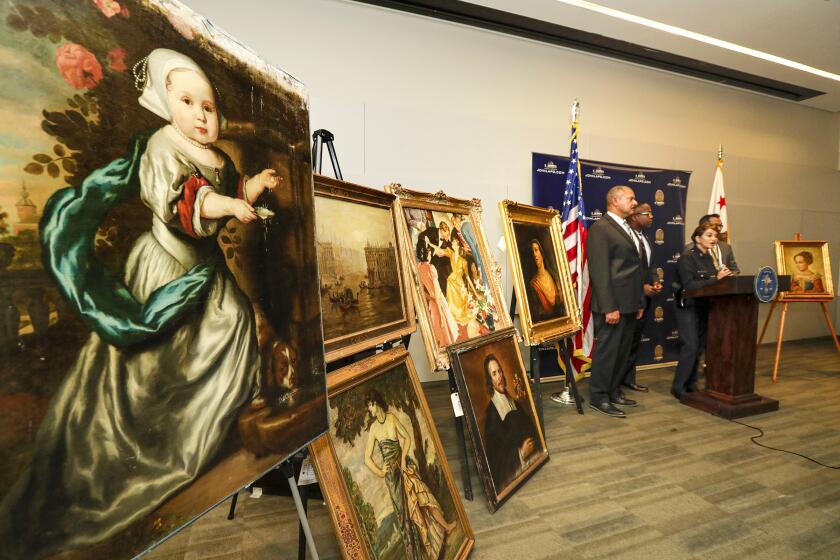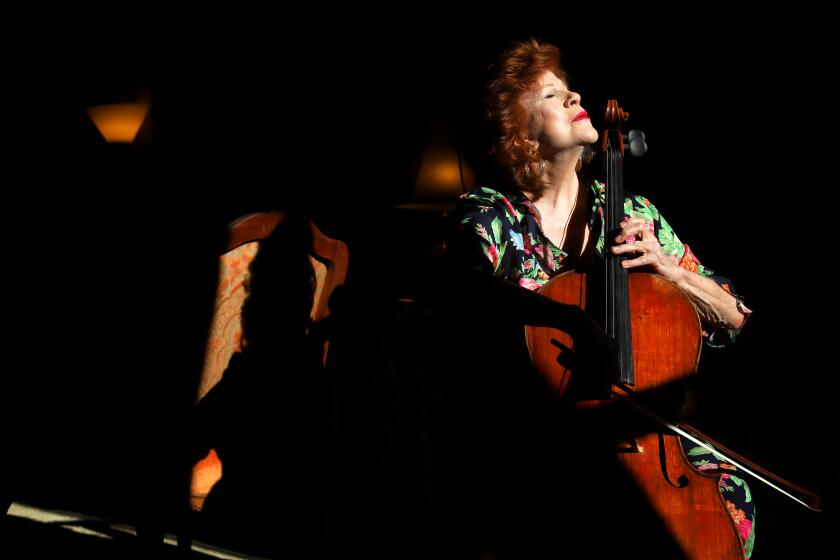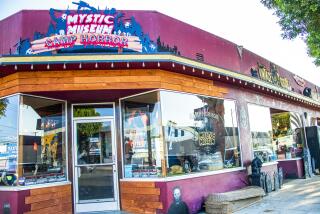Rare 310-year-old violin stolen from art dealerâs Los Feliz home
The FBI is in hot pursuit this Christmas season of a thief who may have music on his mind: A rare 18th century violin has gone missing from a Los Feliz residence.
The stolen violin is a 1710 Amati, a glossy, curvaceous object made from curly maple and alpine spruce that was crafted by one of the most important violin makers in musical instrument history, Hieronymus Amati II. Itâs in excellent condition and, according to auction records, sold for just over half a million dollars in 2013 â it would likely be worth more than $700,000 today.
The 310-year-old violin belongs to Rowland Weinstein, who is not a musician but an art dealer who splits his time between Los Angeles and San Francisco. His Weinstein Gallery, specializing in surrealism and abstraction from 1920 through World War II, is based in San Francisco. The violin, which he allowed musician friends and professional violinists to play, was in his white Tesla, parked outside his Los Feliz home, when someone stole the vehicle from his property Dec. 8.
Weinstein said his car key â which automatically locks the Tesla once the driver, key in hand, exits the vehicle â had slipped out of his pocket and landed behind the driverâs seat. So the car was unlocked.
Ironically, the reason the violin was in the car in the first place was that Weinstein had moved it from a previous location he felt was not safe enough. Heâd intended to leave the instrument in the car only momentarily; when he returned from inside the house, he found the car gone and called the police and then the FBI.
A spokesperson for the FBI, Laura Eimiller, said no suspects have been identified and no one has been charged yet. Neither car nor violin has turned up and itâs not certain, she said, that the instrument was the thiefâs target.
Los Angeles police recovered more than 100 pieces of stolen art and antique firearms this summer after receiving a tip from an auctioneer.
âAccording to LAPD, a car thief is believed to have been in the area,â Eimiller said. âItâs possible that the person who stole it may not have known the value and discovered it [later] and may try to pawn it or sell it overseas. So itâs critical to get the information to the public so that hopefully somebody who received it, or is offered it, can identify it and return it to its rightful owner.â
Weinstein â who is offering a $25,000 reward for information leading to the violinâs safe return â said he is âheartbroken.â
âIâm responsible for a piece of history and that piece of history got away from me,â Weinstein said. âItâs so fragile. My biggest fear is that someone who doesnât know what they have will put it in the wrong environment and it will get damaged or destroyed.â
Weinstein bought the violin in October 2013 at Tarisio, an online auction house specializing in stringed instruments and bows. According to Tarisioâs records, Weinstein paid $507,436 at a London sale. He said he had it insured. Such rare instruments appreciate annually, according to Tarisio director Jason Price, adding that the 1710 Amati would likely sell for $700,000-$900,000 today.
In 2018, another Amati violin, circa 1700, sold at the London-based auction house Ingles & Hayday for $917,453.
Weinsteinâs instrument was so valuable because it was made during a seminal âgolden periodâ in the history of violin making â 1700-1720 â and because the Amati family is credited with birthing the modern violin. The family crafted string instruments in the Italian town of Cremona starting in the mid 16th century. Two generations later, Nicolò Amati ramped up the family workshop and its profile in the 17th century.
Nicolòâs son, Hieronymus Amati II, made Weinsteinâs violin.
âHieronymus the second is a very special violin maker because heâs the last of the Amati lineage,â Price said. âThey essentially created the modern violin as we know it â its proportions, its measurements, its tuning and its number of strings.â
Gary Green, a longtime violinist and founding conductor of the Los Angeles Lawyers Philharmonic, said the instrumentâs value cannot be overstated â historically, musically and personally.
âWhen you play a string instrument â Iâve had mine 60 years â itâs a very personal thing,â Green said. âYou hold a violin very close, under your chin, you create the sound together. ... And an Amati â whoa, what a loss.â
Missing for 40 years, a rare cello surfaces with a surprise ending.
Though Weinstein himself did not play the instrument, âIâm the caretaker of it,â he said. âI feel extremely close to it because itâs a part of history that has touched so many lives. Not just the lives of people who have been lucky enough to play it, but those who have heard it over 300 years.â
This is not Weinsteinâs first run-in with a thief. In 2011 a 1965 Pablo Picasso pencil drawing, âTĂŞte de Femme,â was stolen from his gallery, then located near Union Square (itâs now in the South of Market area). Authorities recovered the sketch in about 24 hours and Mark Lugo of Hoboken, N.J. â a.k.a. the âThomas Crown of art thieves,â who had casually walked out of the gallery, in broad daylight, with the art work tucked under a newspaper before hailing a taxi â was sentenced to 16 months in prison. The work still hangs in Weinsteinâs gallery; he doesnât plan to sell it.
âIt became part of the lore of my career, itâs part of my story,â he said.
Weinstein said heâs baffled by the coincidence of being targeted, twice, by thieves.
âItâs beyond anything Iâd ever anticipated,â he said. âI just hope the violin has the same happy ending as the Picasso.â
Price was optimistic about the violinâs return. The auction house maintains a free database, accessible to the public, of about 60,000 fine musical instruments that includes a registry of stolen ones â both cold cases and instruments that have been recovered. Itâs considered one of the largest such compilations in the industry, and Price has noticed patterns.
âThey go off the map for years sometimes, but then they often resurface,â Price said of stolen pieces. âItâs really difficult to sell an instrument like this because itâs so known and would attract so much attention wherever it popped up for sale. They donât stay stolen long.â
Berkeley Law lecturer Carla Shapreau, a violin maker who specializes in, among other things, stolen cultural objects, suspects Weinsteinâs violin may still be close to home.
âThis doesnât appear to be a planned theft, it seems to be a crime of opportunity based on the facts, so itâs potentially still in Los Angeles, possibly in someoneâs home,â Shapreau said. âWhen a theft is planned, thereâs often a customer for it. When someone sees a car unlocked, theyâre more likely to try and pass [an item found inside] locally. But it would be difficult to transfer this in the stream of commerce, especially if itâs well publicized.â
In addition to Tarisioâs database, both the FBI and Interpol keep databases of stolen cultural objects, Shapreau said, adding that all three are âessential tools.â
âItâs hard to sell these things if theyâre well documented,â she said. âBut if you donât have a way to track them, memories fade.â
The FBI case agent in charge of the Amati violin, Elizabeth Rivas, was not allowed to comment on an in-progress investigation, Eimiller said. Rivas is a member of the FBIâs national art crime team, based in the Los Angeles field office.
The FBI is continuing to investigate the case, Eimiller said, and asks that anyone with information call (310) 477-6565.
More to Read
The biggest entertainment stories
Get our big stories about Hollywood, film, television, music, arts, culture and more right in your inbox as soon as they publish.
You may occasionally receive promotional content from the Los Angeles Times.













